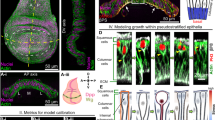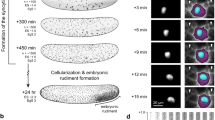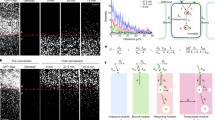Abstract
Every organism develops body patterns that are accurately repeated among individuals of the same species. To understand how cells interact to form these patterns, many investigators have studied the re-establishment of patterns following genetic and/or physical perturbations. In regulating systems, missing structures may be replaced by cell proliferation (epimorphosis) or by respecification without growth (morphallaxis)1. Epimorphosis involves the formation and growth of a blastema2, defined for vertebrate regeneration as a zone of proliferating cells, localized near the wound surface3, which becomes capable of regenerating even when isolated from the rest of the limb4. Clonal analysis of Drosophila imaginal disk fragments indicates that during pattern regulation most dividing cells are located near the wound surface5. Furthermore, mitotic figures (L. C. Abbott, personal communication) and cells incorporating 3H-thymidine6 are clustered near the wound surface of regulating fragments. Here we describe experiments involving cultures of this zone of proliferating cells, and report that it can regulate in isolation. These observations provide evidence that regulation of disk fragments is accomplished by growth of a blastema. Surprisingly, the isolated blastema regenerated more pattern elements than predicted by the polar coordinate model7. We resolve this paradox by proposing that regulation is initiated at free cut edges, where a blastema is formed that adds new positional values in a sequence. On completion of wound healing, blastema growth continues until remaining positional disparities are eliminated by intercalation, as presented in the polar coordinate model.
This is a preview of subscription content, access via your institution
Access options
Subscribe to this journal
Receive 51 print issues and online access
$199.00 per year
only $3.90 per issue
Buy this article
- Purchase on Springer Link
- Instant access to full article PDF
Prices may be subject to local taxes which are calculated during checkout
Similar content being viewed by others
References
Morgan, T. H. Regeneration, 23 (Macmillan, New York, 1901).
Wolpert, L. Curr. Topics Devl Biol. 6, 184–224 (1971).
Goss, R. J. Principles of Regeneration, 146–148 (Academic, New York, 1969).
Stocum, D. L. Devl Biol. 18, 441–480 (1968).
Abbott, L. C., Karpen, G. H. & Schubiger, G. Devl Biol. 87, 64–75 (1981).
Dale, L. & Bownes, M. Wilhelm Roux Arch. dev. Biol. 189, 91–96 (1980).
French, V., Bryant, P. J. & Bryant, S. V. Science 193, 969–981 (1976); 212, 993–1002 (1981).
Duranceau, C., Glenn, S. L. & Schneiderman, H. A. in Insect Biology in the Future (eds Locke, M. & Smith, D. S.) 479–516 (Academic, New York, (1980).
Kauffman, S. A. & Ling, E. Devl Biol. 82, 238–257 (1981).
Strub, S. Nature 269, 688–691 (1977).
Poodry, C. A. in The Genetics and Biology of Drosophila 2d (eds Ashburner, M. & Wright, T. R. F.) 407–441 (Academic, New York, 1980).
Reinhardt, C. A. & Bryant, P. J. J. exp. Zool. 216, 45–61 (1981).
Schubiger, G. Devl Biol. 26, 277–295 (1971).
Schubiger, G. Wilhelm Roux Arch. EntwMech. Org. 160, 9–40 (1968).
Author information
Authors and Affiliations
Rights and permissions
About this article
Cite this article
Karpen, G., Schubiger, G. Extensive regulatory capabilities of a Drosophila imaginal disk blastema. Nature 294, 744–747 (1981). https://doi.org/10.1038/294744a0
Received:
Accepted:
Issue Date:
DOI: https://doi.org/10.1038/294744a0
This article is cited by
-
The role of the peripodial membrane in the morphogenesis of the eye-antennal disc ofDrosophila melanogaster
Wilhelm Roux's Archives of Developmental Biology (1983)
Comments
By submitting a comment you agree to abide by our Terms and Community Guidelines. If you find something abusive or that does not comply with our terms or guidelines please flag it as inappropriate.



